High Speed Rail
Overview
The UK Government initially set out to build a new high speed railway line connecting London with Birmingham, Manchester and Leeds, with HS2 trains continuing along the existing West Coast Main Line to Liverpool, Glasgow and Edinburgh and along the existing East Coast Main Line to Newcastle.
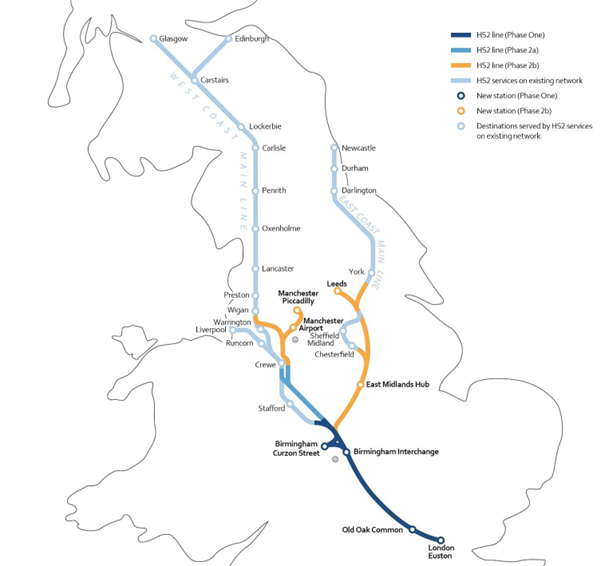
The UK Government published its Integrated Rail Plan for the North and Midlands in November 2021, which confirmed that the eastern leg of HS2 would now be cut short at East Midlands Parkway and HS2 trains would now continue along the existing Midland Main Line to Nottingham and Sheffield. The UK Government will launch new studies to identify alternative means of connecting Leeds to the high speed rail network and will safeguard the initial alignment until that study has concluded. HS2 trains will no longer serve Newcastle.
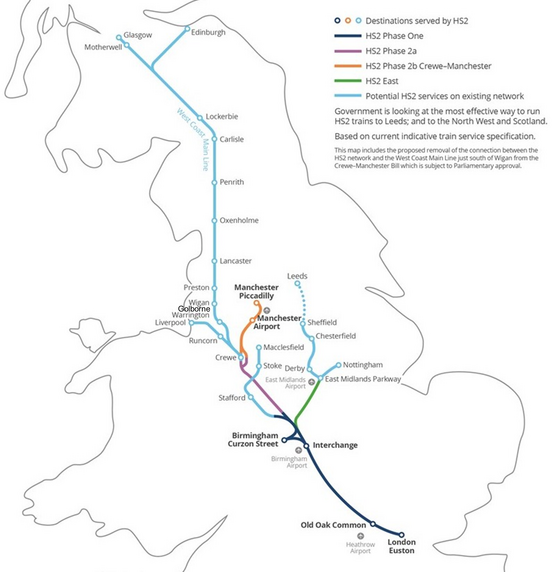
The High Speed Rail (Crewe to Manchester) Bill, which was introduced into the UK Parliament on 24 January, seeks to grant powers to HS2 Ltd to construct the western leg of HS2 Phase 2b, between Crewe, Manchester and Golborne, just to the south of Wigan.
The UK Government subsequently announced on 7 June 2022 that the high speed rail line between the Crewe to Manchester high speed railway and the West coast Main Line at Golborne (the Golborne Link) would be removed, subject to parliamentary approval, from the High Speed Rail (Crewe to Manchester) Bill to enable alternative options to be explored. The Golborne Link would have enabled HS2 services to Scotland to by-pass the congested two track section of the West Coast Main Line between Crewe and Wigan.
High Speed Rail (Crewe to Manchester) Bill also seeks powers to construct a train stabling and light maintenance depot at Annandale, near Gretna. A legislative consent memorandum considering potential Safeguarding of the necessary land was lodged with the Scottish Parliament on 7 February 2022.
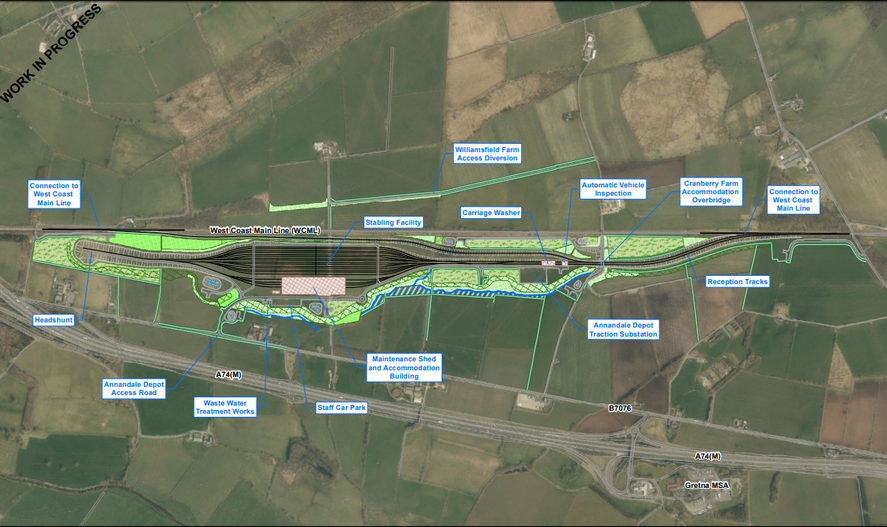
- Read about the layout of Annandale Depot in greater detail
Construction is currently underway on the circa 100 miles phase 1 of HS2 between London and Birmingham, including 4 new or extended stations at London Euston, London Old Oak Common, Birmingham Interchange and Birmingham Curzen Street. Completion is now expected between 2029 and 2033.
When it opens for service, HS2 will release a large amount of capacity on the southern parts of both the existing West Coast Main Lines, as the long distance passenger demand will transfer to the new high speed lines. The decrease in the number of long distance passenger trains using the existing lines will free up significant capacity that can be used for new local and regional train services, benefiting local communities.
The UK and Scottish governments are working together with business and civic leaders throughout northern England and Scotland to support the extension of the high speed rail network beyond Phase 2.
Joint UK and Scottish Government commitment
 Keith Brown and Robert Goodwill at Edinburgh Waverley Station
Keith Brown and Robert Goodwill at Edinburgh Waverley StationOn 21 March 2016, Keith Brown, the then Cabinet Secretary for Infrastructure Investment and Cities made a joint commitment with Robert Goodwill, the UK Minister for Transport.
The Department for Transport, Transport Scotland and Network Rail would undertake work between then and the end of the control period in 2019 to identify infrastructure options with strong business cases that could:
- improve capacity, resilience and reliability on the rail routes between England and Scotland, and
- reduce journey time further towards the joint government target of an air-competitive 3 hour journey time between London and both Glasgow and Edinburgh.
The North of HS2 to Scotland Working Group (comprising of representatives from the DfT, Transport Scotland, HS2 Ltd and Network Rail), was formed to deliver this commitment.
Feasibility studies
The Department for Transport, on behalf of the Working Group, commissioned Network Rail to compile a short-list of the better performing infrastructure options that merited further in-depth study. The shortlist was compiled from around 200 options that had been identified from previous studies undertaken by Transport Scotland, HS2 Ltd and Network Rail.
Transport Scotland, on behalf of the Working Group, commissioned further Feasibility Studies, which were completed in 2018.They focused on the east coast route between Edinburgh and Newcastle and on the west coast route between Glasgow and Preston.
East Coast study
The east coast study confirmed it was technically and environmentally feasible to construct an additional line between the outskirts of Edinburgh and Newcastle. This additional line would free up space on the existing East Coast Main Line which could be used for additional passenger and freight services.
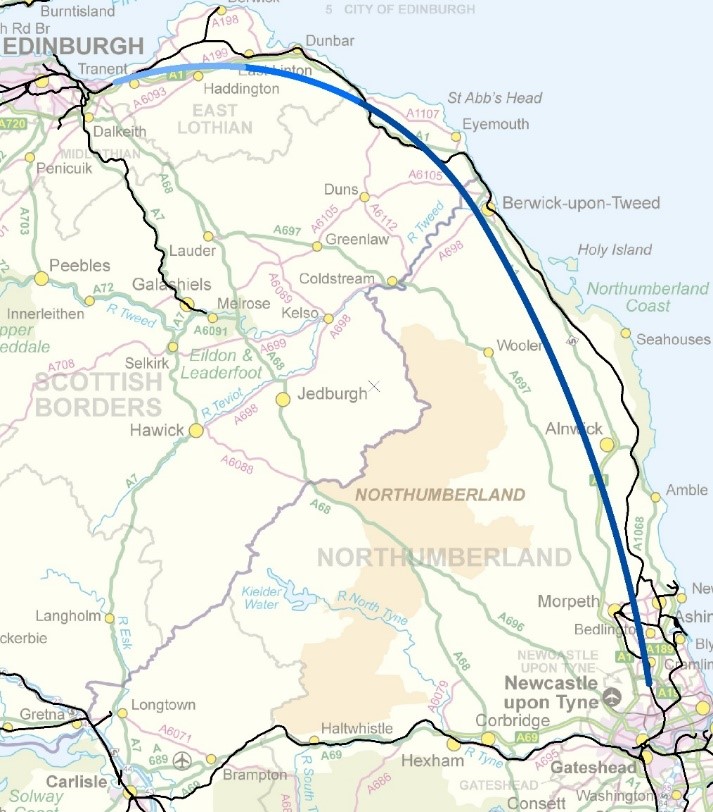
Vector representation of East Coast option
(not actual route).
The construction of this line could be phased to realise early benefits from the additional capacity and reduction in journey time. High-speed trains running on the new line could be capable of a sub 45 minute journey time between Edinburgh and Newcastle. A journey time of approximately 3 hours between Edinburgh and London could also be possible in combination with the HS2 lines running between London and Leeds.
Most passengers travelling between London and Edinburgh choose the east coast route so it is likely that there could also be greater demand for high speed rail services using an east coast routing, which would also take pressure off the congested west coast route.
Newcastle station
A barrier to extending high speed rail services along the east coast to Edinburgh is platform length in Newcastle Station, as the projected high level of passenger demand would require the service to be operated by 400m long trains.
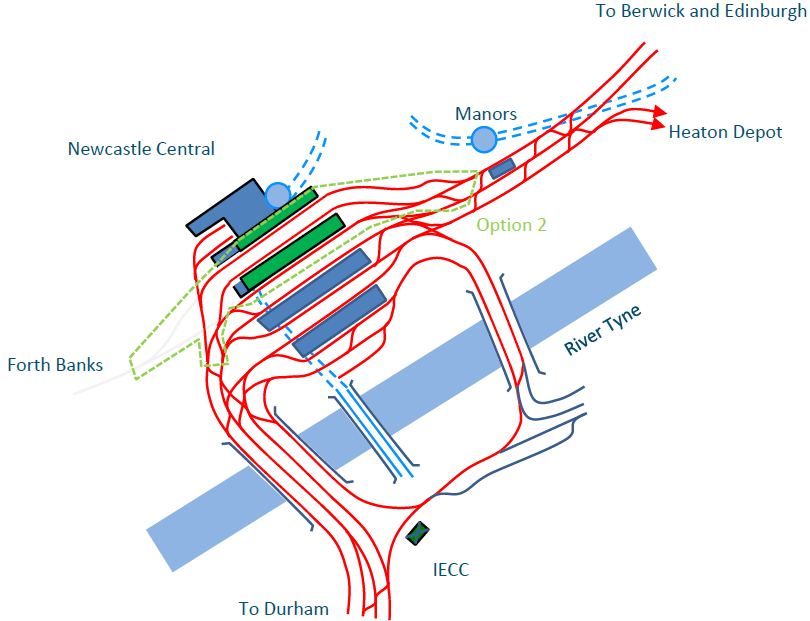
Diagram representing platform extension option at Newcastle Station
(reproduced from Network Rail).
To overcome this barrier, on behalf of the Working Group, we commissioned Network Rail to identify cost effective options for extending two or more platforms to accommodate 400m long trains that could be accessed from a new and/or extended footbridge.
The study confirmed that the option to join bay platforms 9 & 10 with bay platforms 1 & 0 to create two through platforms (illustrated in green on the adjacent diagram), accessed from a new and extended footbridge, could be implemented at less than 20% of the perceived cost of an alternative underground concourse. This option would improve both the operation and the accessibility of the station.
West coast study
Our west coast study confirmed that it was technically and environmentally feasible to construct an additional line between either Abington or Carstairs and Rutherglen, illustrated by the purple and pink lines respectively in the adjacent map.
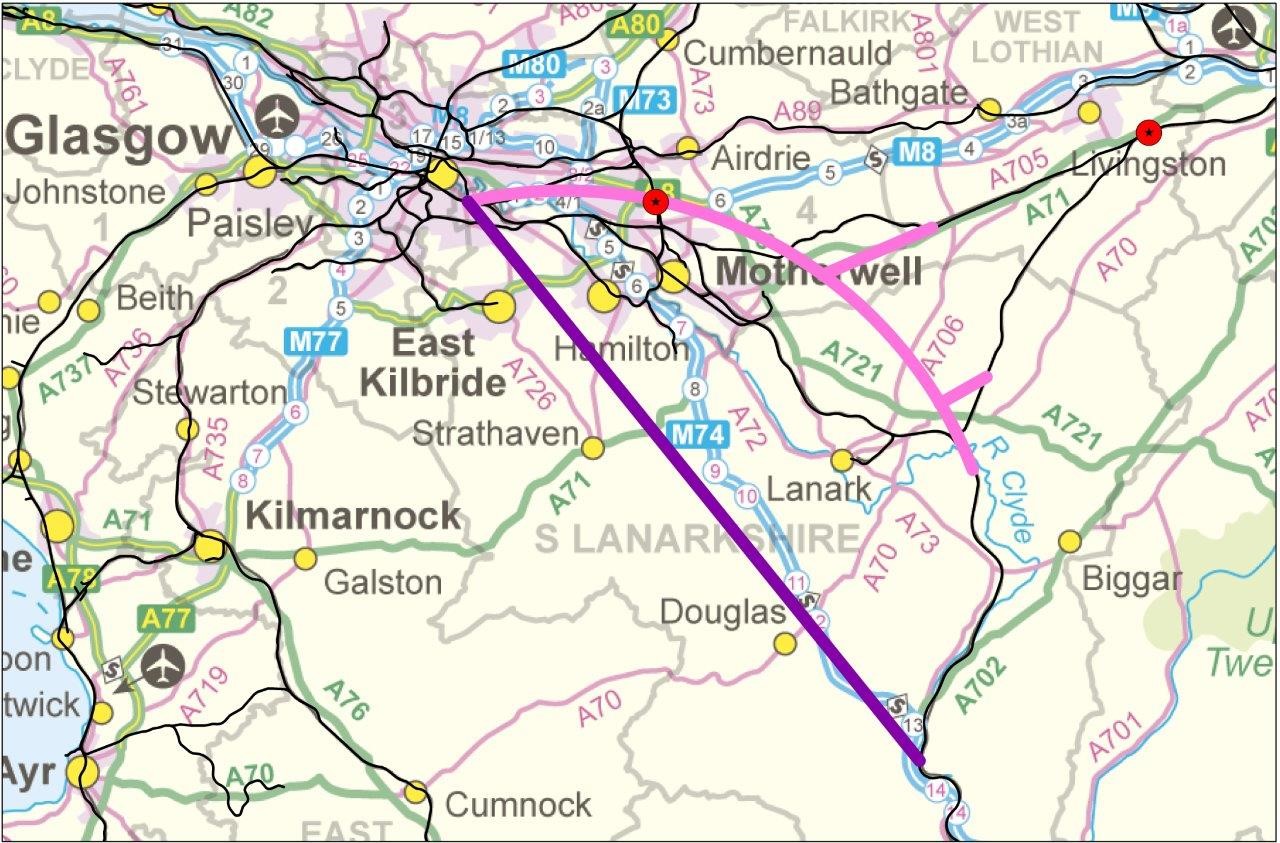
Vector representation of West Coast option from Abington to Carstairs or Rutherglen
(not actual route).
The route option via Carstairs, illustrated by the pink line in the adjacent map, has intermediate connections with the existing rail network. This could allow a 90 minute journey time between Glasgow and Newcastle over both the west and east coast options. in addition to a 5½ minute journey time reduction between Carlisle and Edinburgh.
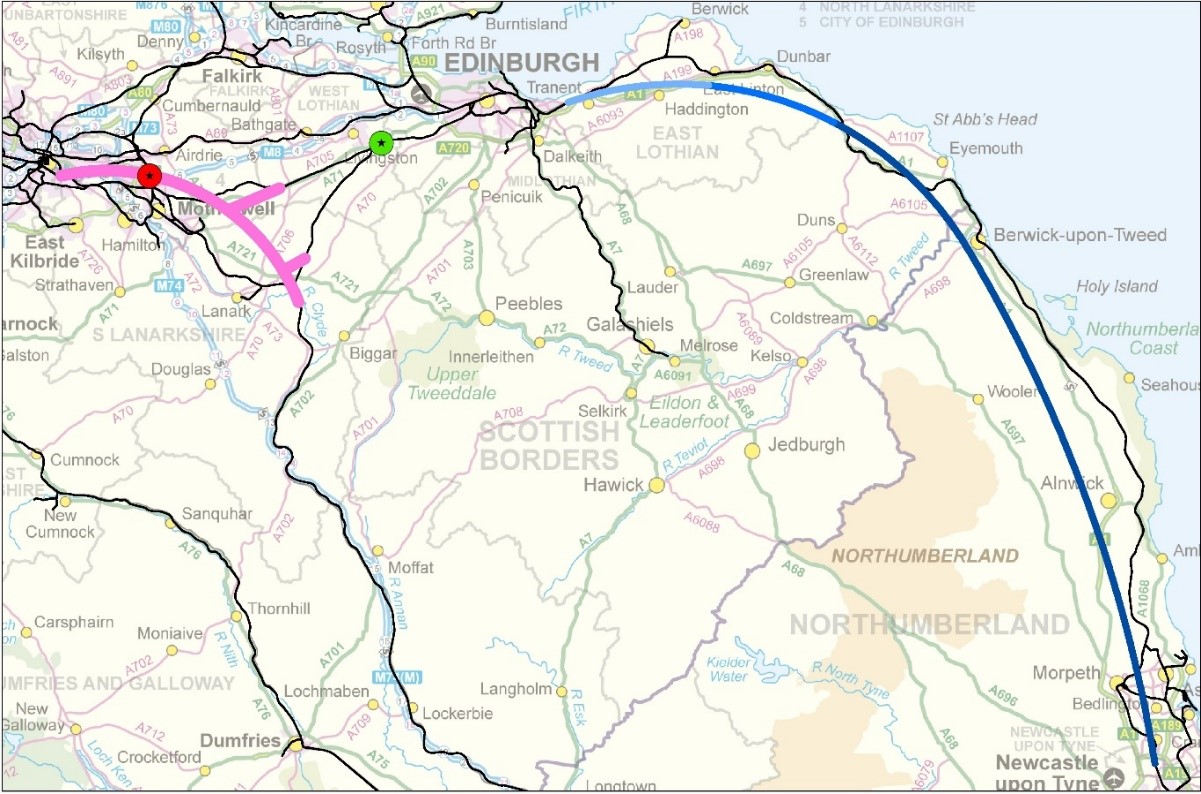
Vector representation of option via Carstairs
(not actual route).
Potential new stations on the new high speed line within the Eurocentral business park and on the existing rail network near Livingston, illustrated by the red and green circles respectively in the adjacent map, are being considered, as is a potential new station in East Lothian.
Business case
The output from these Feasibility Studies will be used to inform a Business Case which will be presented to UK and Scottish Government Ministers with recommendations for their consideration in the light of the joint commitment they made in March 2016. Work on the Business Case has however been paused.
High Speed Rail Scotland Stakeholder Group
The High Speed Rail Scotland Stakeholder Group (initially known as the Scottish Partnership Group) was formed in 2011 to develop and promote Scotland's case for inclusion in a UK-wide, high speed rail network.
The group brings together representatives from Scotland's communities, businesses, councils and regional transport partnerships, who bring local knowledge and expertise to the project. The Group ensures Scotland speaks with one voice in support of high speed rail.
The Group includes representatives from:
- ADS
- CBI – Confederation of British Industry
- CBRE Group
- Chambers of Commerce
(Scottish, Edinburgh and Glasgow) - Councils
(Dunfries and Galloway, East Lothian, Edinburgh City, Glasgow City, North Lanarkshire West Lothian) - Network Rail
- Scottish Association for Public Transport
- Scottish Council for Development and Industry
(Chair) - Scottish Cities Alliance
- Scottish Enterprise
- Scottish Futures Trust
- Transform Scotland
- Transport Partnerships
(Hitrans, Nestrans, SEStran, SPT, SWestrans Tactran) - Transport Scotland
(Secretariat Support) - Visit Scotland
Publications
- Transport Scotland’s High Speed Rail Scotland Summary Report - 21 March 2016
- HS2 Ltd’s Broad options for upgraded and high speed railways to the North of England and Scotland report - 21 March 2016
- Transport Scotland’s Fast Track Scotland- 14 December 2011